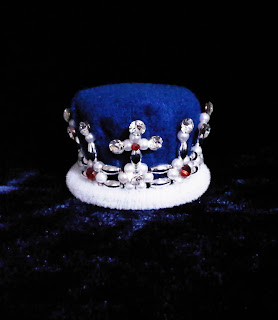Crowns and Tiaras are my favourite topic and I have been interested and inspired by this particular field of jewellery since I can remember. For today's blog post we will discuss the traditional origins of Crowns in particular and their current place as official symbols of Royalty and national identity.
To adorn the head must have come to the mind of ancient man for two primary reasons. The head has always and obviously been recognised as the seat of man's conscious mind and intellect and to adorn it would be to substantiate and honour man's intellectual supremacy over the earth and all its creatures. The other reason would be far less esoteric but then also far more obvious as well. The face being the manifestation of identity and inherently beautiful in itself would inspire adornment in the form of ear rings and nose rings but above all, head jewellery. So the more important people would also increase in their wear of jewellery due to their status and wealth. Very soon official jewels would have official function to substantiate office and rank and the apex would always end up being the crown. Crowns as the ultimate jewellery object was probably due to its symbolic place on the head of a person who in turn would be the head of a social hierarchy. Another reason would be that a crown in practicality allows for the greatest weight in gold and jewels. Slowly the crown settled itself symbolically in our human history and indeed our consciousness.
Crowns and Crown Jewel Collections in later years began to serve a very practical purpose. As Kingdoms grew in size these jewels became the national repository of wealth and collateral for entire countries. Often Kings might even pawn their jewels in order to wage war or build massive cities. The Crown indeed became completely amalgamated with the concept of Kingdom, King and Royalty. They became the symbols of national identity and prestige. Crowns eventually evolved into specific designs in order to differentiate the various Kingdoms or Empires. A King's crown would have different aspects to that of an Emperor or Prince and two Kings crowns would also have different national symbols incorporated.
Some Crowns have survived for centuries while other were pawned or lost during revolution or theft. Here are some of the Crowns from history while some survive and are exhibited others are lost forever or just kept out of the public eye.
An old archive photo of the Crown of St Christian which was the coronation crown for the Kingdom of Scotney. It was one of the oldest crowns in Europa with an amazing history. It was unfortunately lost during the 96 revolution.
The more modern and less jewel encrusted Crown of the Kingdom of Britania. It was destroyed in the Castle Roswind fire during the 96 revolution.
Other Crowns destroyed during the revolution was the modern Crown of Syldavia, the smaller medieval Crown of Hispania and several lesser crowns and coronets of various lower ranking Royals.
The Ruskian Imperial Crown depicted in this State Portrait has been lost since the Great War brought the Imperial monarchy of Ruskiana to its downfall.
The old historic Crown of Syldavia survived the revolution and is currently the official crown of the restored monarchy along with the brand new Queen's Coronet.
The Royal Crown of the Kingdom of Hispania was a new crown made to replace the medieval one destroyed during the revolution. It does however contain gems and gold components from a far older crown. The deteriorating crown used to create the new one, was used to crown a relic in the Royal Cathedral of St Bartholomeas.
Applying the national colour of light blue, the nation of Normandia also made a brand new crown for the restoration of their monarchy.
Wallachia has two medieval circlet style crowns which are probably the oldest in Europa and they are very rarely used and not exhibited at all.
The official symbol of the monarchy in Swann is a typical crown of a Sovereign Duke. This type of crown lacks the upward rising arches of a King or Emperor's crown.
The Imperial Crown on the blue pedistal at right is the single most valuable jewellery piece in the world.
The Imperial Crown Jewels of the United Empire were displayed at the Crown Prince Imperial's Ball in 2009. Rumours about a public exhibition abound but the Imperial Family have yet to make an official statement regarding the matter.











I love the history of the crowns! Just think about it all the preciious jewels anyone would want! Now for the crowns on the pedestal. Where are the royal guards? You are going to have to add a few to protect them, lol.
ReplyDeleteThanks for your comment. I do have guards, they just stay out the pictures, hahaha. I'm glad you enjoy my jewellery, it is what this blog is all about.
Delete